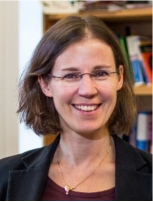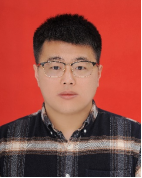报告一:Multinary Clusters: Atomically Precise Nanoobjects with Uncommon Properties
报告人:Prof. Stefanie Dehnen, Karlsruhe Institute of Technology

报告摘要:The properties of materials based on cluster compounds is largely affected by the diverse compositions and uncommon structural motifs of these nanoobjects, which result in functionalities with great potential for practical use.[1-5] We control the elemental composition by starting out from p-block element precursors that are reacted with further metal complexes or organic compounds. Depending on the chosen elemental combination, the products represent clusters of the metallide or metalate type. Some of the molecular architectures remain unsubstituted, like [K2Zn20Bi16]6– [5] or [An@Bi12]q– (An/q = U/3, Th/4),[6,7] and serve to understand fundamental aspects like electronic properties, cluster formation, and bonding. The aggregation of cluster molecules, such as in [Cs@Ge4(Ge4Se10)4]7–,[8] and the presence of of organic substituents,[10-14] like in [{CpRu}3Bi6]–,[11] [{(Me3Si)2NZn}2Bi6]2–,[12] [{(IMes)Co}2Bi5],[13] or [Sn10O4S16(SBu)4]4–,[14] additionally influence the chemical and physical properties. This leads to unique features, like extreme nonlinear optical response found in materials based on [(StySn)4S6] and related clusters.[15]

Multinary clusters without or with organic functionalization: [Th@Bi12]4–, [Sn10O4S16(SBu)4]4–, and [(PhSn)4S6].
References:
[1] Zhang, J.; Bu, X.; Feng, P.; Wu, T. Acc. Chem. Res. 2020, 53, 2261.
[2] McGrady, J. E.; Weigend, F.; Dehnen, S. Chem. Soc. Rev. 2022, 51, 628.
[3] Wilson, R. J.; Lichtenberger, N.; Weinert, B.; Dehnen, S. Chem. Rev. 2019, 119, 8506.
[4] Pan, F.; Peerless, B.; Dehnen, S. Acc. Chem. Res. 2023, 56, 1018.
[5] Eulenstein, A. R.; Franzke, Y. J.; Bügel, P.; Massa, W.; Weigend, F.; Dehnen, S. Nat. Commun. 2020, 11, 5122.
[6] N. Lichtenberger, R. J. Wilson, A. R. Eulenstein, W. Massa, R. Clérac, F. Weigend, S. Dehnen, J. Am. Chem. Soc. 2016, 138, 9033.
[7] Eulenstein, A. R.; Franzke, Y. J.; Lichtenberger, N.; Wilson, R. J.; Deubner, L.; Kraus, F.; Clérac, R.; Weigend, F.; Dehnen, S. Nat. Chem. 2021, 13, 149.
[8] Wu, Z.; Weigend, F.; Fenske, D.; Naumann, T.; Gottfried, J. M.; Dehnen, S. J. Am. Chem. Soc. 2023, 145, 3802.
[9] Pan, F.; Wei, S.; Guggolz, L.; Eulenstein, A. R.; Tambornino, F.; Dehnen, S. J. Am. Chem. Soc. 2021, 143, 7176.
[10] Wei, S.; Peerless, B.; L. Guggolz, S. Mitzinger, S. Dehnen, Angew. Chem. Int. Ed. 2023, 62, e202303037.
[11] Peerless, B.; Schmidt, A.; Franzke, Y. J.; Dehnen, S. Nat. Chem. 2023, 15, 347.
[12] Schmidt, A.; Rienmüller, J,; Weigend, F.; Dehnen, S. Angew. Chem. Int. Ed. 2025, 64, e202417234.
[13] Rienmüller, J., Peerless, B., Paul, S.; Bruder F.; Wernsdorfer, W.; Weigend. F.; Dehnen S. Nat. Chem. 2025, 17, 547.
[14] Peters, B.; Stuhrmann, G.; Mack, F.; Weigend, F.; Dehnen, S. Angew. Chem. Int. Ed. 2021, 60, 17622.
[15] Rosemann, N. W.; Eußner, J. P.; Beyer, A.; Koch, S. W.; Volz, K.; Dehnen, S.; Chatterjee, S. Science, 2016, 352, 1301.
报告二:ACS Publications: Empowering Researchers to Pursue Academic Excellence
报告人:曹瀚博士,美国化学会出版部

Dr. Han Cao has been a Managing Editor at ACS Publications since 2022, overseeing content development, strategic engagement, and academic collaborations in China for chemistry journals specializing in organic-inorganic chemistry and polymer science, including ACS Central Science, ACS Catalysis, Organic Letters, Inorganic Chemistry, Macromolecules, etc. He earned his B.S. in Chemistry from Nankai University and received his Ph.D. in Polymer Physics and Chemistry from the University of Science and Technology of China. Prior to joining ACS Publications, he conducted sustainable polymer research at Changchun Institute of Applied Chemistry, Chinese Academy of Sciences (CAS), supported by the National Natural Science Foundation of China, and Youth Innovation Promotion Association of CAS.
报告摘要:This lecture will introduce ACS Publications’ key resources and initiatives that serve the global research community and discusses practical aspects of scholarly publishing. Topics include selecting an appropriate journal, preparing a clear and concise manuscript, and understanding the editorial and review process. Insights from ACS editors will be shared to help researchers navigate publication more effectively and participate with confidence in international academic exchange.
报告三:Structural Evolution and Functional Modulation of Metal Nanoclusters
报告人:王泉明教授,清华大学
王泉明,清华大学教授,化学系副主任,系学术委员会副主任。国家杰出青年科学基金获得者,国家重点研发项目负责人。厦门大学学士(1989)、硕士(1992),香港中文大学博士(2001)。2005-2015年任厦门大学化学化工学院教授;2015年6月至今,任清华大学教授。现为中国晶体学会理事,《Fundamental Research》、《无机化学学报》和《结构化学》编委。主要从事金属团簇的可控合成及其在发光、催化等方面的应用研究。
报告摘要:金属团簇结构新颖、性能丰富,备受关注。由于金属团簇的形成牵涉到多个组分(金属原子、离子以及配体)的组装,其控制合成极富挑战性。配体作为金属团簇中不可或缺的一部分,在团簇结构和性质的控制上扮演着多种角色。配体工程就是在金属团簇的表面对配体进行精准组织,从而实现团簇物理化学性质的调控。近年来的研究进展表明配体工程在团簇结构控制和发光性能调控上发挥着重要的作用。通过对团簇刚性的增强和激发态的控制,可以获得具有高量子产率的室温磷光,其发光范围可以从可见光延伸至近红外区域。这些团簇具有优异的化学稳定性和强发光性,在生物成像和手性传感方面具有潜在的应用前景。
报告四:Separation of Actinide Elements Based on Molecular Design
报告人:石伟群教授,上海交通大学

石伟群, 上海交通大学特聘教授,核燃料循环与核材料研究所所长,国家杰出青年科学基金获得者。2007年1月在清华大学化学系获博士学位。长期致力于核燃料循环化学相关基础研究,在JACS、Angew.Chem、Chem.、CCS Chem.、Nat.Commun、Adv.Mater.等国际知名期刊发表SCI 论文400余篇,成果被国内外同行广泛关注和引用,文章总引两万余次, H因子71 (Google Scholar),2020-2024年连续入选Elsevier中国高被引学者榜单(核科学技术)。分别担任期刊《Supramolecular Materials》副主编,《Industrial Chemistry&Materials》、《Chinese Chemical Letters》、《Journal of Nuclear Fuel Cycle and Waste Technology》、《International Journal of Advanced Nuclear Reactor Design and Technology》和《Journal of Nuclear Science and Technology》的编委与国际顾问编委,中文期刊《化学学报》、《高等学校化学学报》、《核化学与放射化学》、《核动力》编委。现为中国核学会锕系物理与化学分会副理事长、中国有色金属学会熔盐化学与技术专业委员会副主任委员、中国化学会核化学与放射化学专业委员会委员、中国核学会核化工分会常务理事兼副秘书长。
报告摘要:Separating actinides from lanthanides is essential for managing nuclear waste and promoting sustainable nuclear energy development. In 2014, we reported a phenanthroline-based tetradentate ligand with hard–soft donors combined in the same molecule, N,N′-diethyl-N,N′-ditolyl-2,9-diamide-1,10-phenanthroline (Et-Tol-DAPhen), for the group separation of actinides over lanthanides. The ligand exhibits excellent extraction ability and high selectivity toward hexavalent, tetravalent, and trivalent actinides over lanthanides in highly acidic solution and hence renders huge potential opportunities in high-level liquid waste (HLLW) partitioning. Recently, based on the DAPhen ligand, we proposed a dual strategy to designing covalent organic frameworks (COFs) that skillfully combines molecular rigidity with flexibility, integrating both hard and soft donor atoms in the synthesis of monomers, which results in a specialized COF that efficiently and selectively captures TRUs from acidic aqueous solutions. By utilizing the topological arrangement of rigid ligands to influence the twisting and stretching of flexible ligands, coordination environment featuring nitrogen and oxygen is created, which enhances the separation of transuranium in various oxidation states over lanthanides. In 0.5 m HNO3 solution, the as-synthesized DAPhen-COF achieves removal rates of 99.1% for Np(V) and 95.8% for Pu(IV). For Am(III), the removal rate reaches 98.6% in 0.01 m HNO3. DAPhen-COF exhibits remarkable selectivity for Np(V), with a separation factor of over 5000 for Np/Gd, outperforming other solid-phase materials.
On the other hand, traditional solvent extraction and separation of actinide elements generally relies on specific organic ligands. Through the selective complexation of these ligands with the target actinide metal ions, their efficient separation in a mixture of metal ions can be achieved. The separation selectivity mainly depends on the degree of pre-organization of the ligand structure and the complexation between soft/hard complexing atoms and the target ions. Based on years of research on actinide coordination supramolecules, we proposed a new paradigm for the separation of actinide elements (actinide nano-extraction) by using coordinated assembly of nanoclusters as the extracted species state. That is, using macrocyclic pyrogallol[4]arene as an extractant, it captures and chelates uranyl ions at the water phase/organic phase interface and in-situ assembles to form a uranyl coordination nanocage, realizing the efficient extraction and separation of uranyl ions. Studies have shown that each coordination nanocage is assembled from 6 pyrogallol[4]arene macrocycles and 24 uranyl ions. Multiple components exhibit multivalent cooperativity during the assembly process, which can achieve high selectivity and efficiency for uranyl ions. This new idea of actinide separation based on the extracted species of coordinated assembly nanoclusters is an important application of the concept of supramolecular assembly in the fields of radiochemistry and radionuclide separation.
报告五:Three-dimensional Covalent Organic Frameworks
报告人:汪成教授,武汉大学
Dr. Cheng Wang is a Professor at the College of Chemistry and Molecular Sciences, Wuhan University, and a recipient of the National Science Fund for Distinguished Young Scholars of China. He obtained his B.S. degree from Wuhan University in 2003 and his Ph.D. from the Institute of Chemistry, Chinese Academy of Sciences in 2008 under the supervision of Prof. Deqing Zhang and Academician Daoben Zhu. From 2008 to 2012, he carried out postdoctoral research at Northwestern University with Prof. Fraser Stoddart.
Dr. Wang’s research centers on organic porous materials, with a particular focus on three-dimensional covalent organic frameworks (3D COFs). He has addressed several fundamental challenges in this field, including topology design, crystal structure determination, building block development, and functional applications. He has published over 50 papers as corresponding author in leading journals such as Science, J. Am. Chem. Soc., Angew. Chem. Int. Ed., and Nat. Commun.. His work has been cited more than 6,000 times.
报告摘要:Covalent organic frameworks (COFs) represent an emerging class of crystalline polymers with structural periodicity and inherent porosity and have attracted considerable attention over the past decade for promising applications in gas storage and separation, catalysis, sensor, optoelectronic devices and energy storage. Based on the covalent connectivity in different dimensions, COFs can be categorized into either two-dimensional (2D) layered structures or three-dimensional (3D) extended networks. Until now, most of work has focused on 2D COFs. In contrast, 3D COFs have been much less investigated, although they can possess numerous open sites and hierarchical pore structures that would make them attractive for gas adsorption and catalysis. This underdeveloped status can be attributed to their challenging synthesis, limited structural diversity and complicated structural determination. In this talk, we will present our recent progress in 3D COFs.
报告六:The Power of Less: From Synthesis to Unusual Reactivity in Low-Coordinate Low-Valent Late Transition-Metal Complexes
报告人:邓亮研究员,中科院上海有机所
Prof. Liang Deng is a Professor at the Shanghai Institute of Organic Chemistry (SIOC), Chinese Academy of Sciences. He earned his B.S. from Peking University (2002) and his Ph.D. from The Chinese University of Hong Kong (2006, supervisor: Prof. Zuowei Xie). After completing postdoctoral training at The Chinese University of Hong Kong (supervisor: Prof. Zuowei Xie) and Harvard University (Prof. R. H. Holm), he commenced his independent career at SIOC in 2009. His research program is centered on organo-transition-metal chemistry, small molecule activation, and 3d metal-catalyzed hydrosilylation reactions. An author of over 90 publications, Prof. Deng has made contributions to his field. He also holds editorial roles as an Associate Editor for Organometallics and serves on the editorial boards of several other chemistry journals.
报告摘要:The knowledge on the formation, structure, and reactivity of low-coordinate transition-metal species forms the basis for the development of new 3d metal-catalyzed organic transformations and also disclosing the mysterious mechanisms of catalytic reactions. Aiming to deepen our knowledge on this type of reactive metal species, we have been working on the chemistry of low-coordinate zero-valent cobalt, iron and manganese complexes with N-heterocyclic carbene (NHC) and olefin ligation. This ligand set is found effective in stabilizing three-coordinate cobalt(0, -I), iron(0, -I), and manganese(0) complexes in the forms of [(NHC)M(olefin)2]0,1-. In this presentation, the synthesis, electronic structure, and reactivity of the three-coordinate zero-valent metal complexes, as well as their synthetic applications, will be discussed.